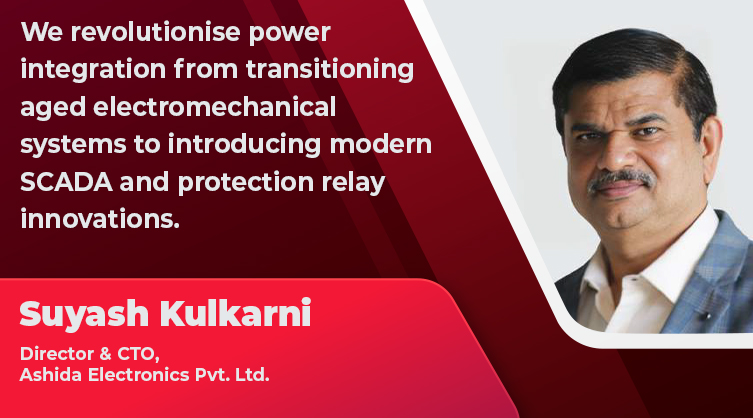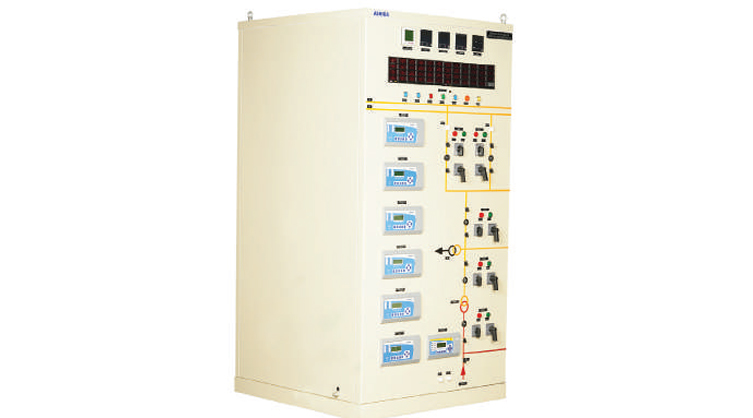Innovative protection devices powering efficiency and precision in substation
By EPR Magazine Editorial September 26, 2023 2:32 pm IST
By EPR Magazine Editorial September 26, 2023 2:32 pm IST

We revolutionise power integration from transitioning aged electromechanical systems to introducing modern SCADA and protection relay innovations.
In an interview with EPR Magazine, Suyash Kulkarni, Director & CTO of Ashida Electronics Pvt. Ltd., discusses measures to seamlessly integrate SCADA systems, upgrade protection relays, and enhance fault location techniques for power substations.
What measures do you take to ensure seamless integration of SCADA systems with the existing infrastructure and third-party issues, especially for power substation efficiency and data accuracy?
The latest challenge is not only for integrators but also for power systems. The equipment used in power systems was predominantly electromechanical or static, there are some communicable relays but having a variety of nonstandard protocols, unlike present days most of manufactures follow standard IEC 60870-103 or IEC61850 protocols. These relays, were functioning well in isolation. However, integrating them into a modern production system and SCADA system poses a considerable challenge.
In order to overcome this difficulty, we created a small, modular RTU with customisable DI/DO that can sense the condition of a number of ageing, non-communicative components, including circuit breakers, isolators, electromechanical relays, etc. Additionally, we created specialised analogue cards that can sense CT and PT waveforms and numerically calculate all electrical parameters. This RTU supports a wide range of protocols, even outdated ones. We can provide bespoke solutions very effectively and efficiently since all SCADA components, including RTU, SCADA software, and modems, are designed, developed, and manufactured in India.
The first stage in deploying any SCADA system is to conduct a survey to identify equipment, establish a communication architecture, and configure our system appropriately.

Which methodologies and technologies to use to enhance the protection release performance and their inability to deal with industry standards?
The evolution of protection relays has seen various stages, including electromechanical protection relays, static protection relays, microprocessor-based protection relays, and numerical protection relays. When we ventured into this market, microprocessor-based and numerical technologies were relatively new, with only a few companies offering them. In the Indian context, most existing infrastructure relied on electromechanical relays. Multinational companies introduced numerical technologies to Indian industries, the product hey offered was having very large functions, having complex user interface, and required skill person to commission. Industry was not initially prepared to adopt these technologies due to the skill gap. Numerical technologies were vastly different, requiring a unique skill set, while the industry primarily consisted of mechanical and electrical engineers.
To address this situation, we initially introduced numerical relay with user interface similar to static relays, which offered significant performance improvements and were compact and easy to understand. Our numerical relays provided a one-to-one replacement for electromechanical relays, making them user-friendly for existing operators.
These numerical relays have gained popularity today, delivering substantial performance improvements over existing technology with enhanced accuracy. We have dedicated teams for electrical research, continuous improvement of electrical features, and advanced simulation tools. Collaborations with institutions like IITs allow us to conduct ongoing research and develop new algorithms for improved accuracy and performance, reflecting our commitment to innovation and progress in this field.
Can you shed some light on your approach to customising these protection relays and numeric relays for various power requirements?
Our approach revolves around delivering tailored solutions to our customers. For instance, many multinational companies offer comprehensive numerical relay solutions encompassing multiple functions. However, in price-sensitive Indian industries, such all-in-one solutions tend to be prohibitively expensive. We believe in providing precise, straightforward solutions for specific needs.
Let’s consider an example: if a customer requires voltage monitoring relays, we offer compact relays equipped with all the benefits of numerical technology and communication capabilities but focused solely on voltage monitoring. We do not advocate purchasing a single box with multiple functions, most of which may never be used. Why pay for nine functions that will likely never be utilised? Our philosophy is customising our products to suit specific requirements while upholding standards.In our product range, you’ll find straightforward overcurrent relays alongside complex multifunction overcurrent and voltage relays. This approach allows us to cater to our customer’s unique needs without burdening them with unnecessary features and costs, striking a balance between customisation and standardisation.
Which recent innovations have been made to change further that offer improved monitoring, control, and automation in power substations?
When a fault occurs, the production realist detects it and disconnects the electric supply. However, pinpointing the exact fault location poses a challenge. To locate the fault, utility personnel must physically patrol the area, identify the fault location, take corrective actions, rectify the issue, and restart the system. This process consumes time. If the equipment could accurately determine the fault’s location or provide an approximate location, it would significantly benefit utilities by saving time. High-end products offer location features but are typically costly and may need to be more affordable, especially in lower KV systems.
We recently conducted comprehensive research in collaboration with external partners, the details of which we cannot disclose. This research focused on identifying the factors affecting fault locations. Subsequently, we developed specialised algorithms that provide a reliable fault location estimation. This approach allows utility personnel and electrical engineers to locate faults efficiently, resulting in substantial time savings.
As part of our efforts to provide solutions, we have incorporated fault location techniques into our traction products, which are successfully deployed in the Mumbai suburban area, addressing a critical need. Additionally, we are introducing over-three-phase relays in a lower price range to make these advanced features more accessible.
Spokesperson – Suyash Kulkarni, Director & CTO, Ashida Electronics Pvt. Ltd.
We use cookies to personalize your experience. By continuing to visit this website you agree to our Terms & Conditions, Privacy Policy and Cookie Policy.